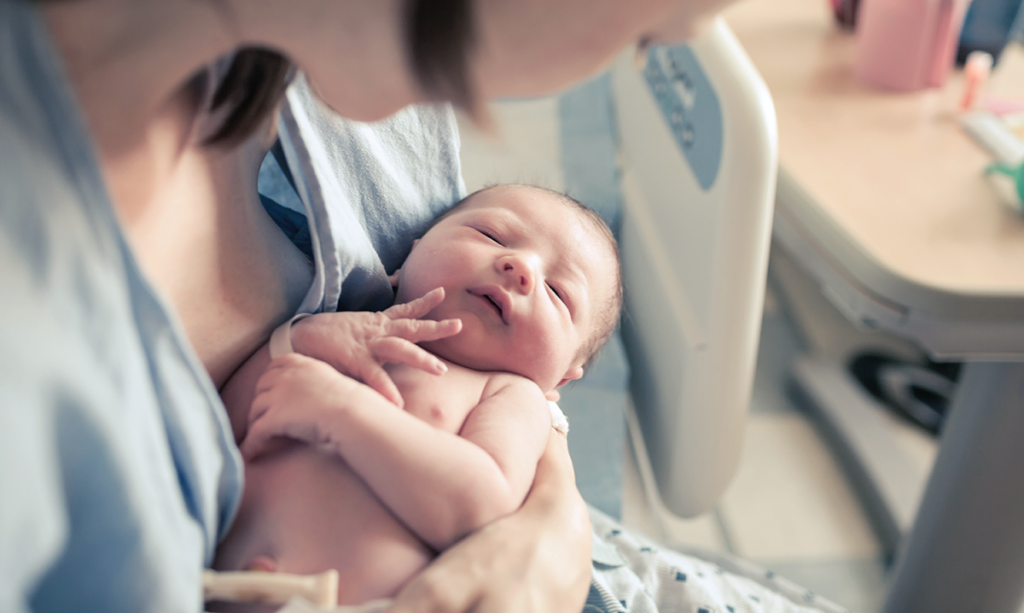You find a creative way to surprise your significant other with the exciting news. You both jump for joy, then stop in your tracks and think, now what? And the fun begins — preparing, planning … and a million butterflies in your stomach. Don’t worry. Whether it’s your first, second, or you’ve lost count, we’ve got the info on classes, hospitals and more to get you started.
Preparing for Baby: Birthing / Maternity Classes

There’s a class for everything and everyone when a new baby is on the way – even for grandparents! Michelle Beebe, manager of perinatal outreach at Kettering Health Network says birthing and maternity classes are the best way to ease a parent’s mind.
“The day you become a parent is one of the most important days of life, and we want this to be a joyful experience,” Beebe says. “First time parents benefit from participating in Childbirth Education Classes. Preparation nurtures a women’s ability to give birth and to trust her instincts while promoting bonding with a partner,” she says.
Another benefit of taking classes is that couples get to process information ahead of Baby’s delivery which helps to prevent frantic, last minute decision making.
Kettering Health Network offers a variety of classes covering any concerns parents may have.
There’s Kettering’s “Baby Care” classes, covering everything you need to know in the first two weeks of Baby’s life.
Sibling class teaches children ages 2 – 10 how to take on the big brother/sister role. Children attend class with a parent or grandparent and learn all of the big sibling basics, watch a video and get toured through the hospital.
Beebe says these classes are terrific, too:
Childbirth Preparation: Instructors guide you through the birth process and answer questions. You gain confidence by learning about and discussing emotions, pain relief options, relaxation, breathing techniques and medications.
Breastfeeding Class: Couples have the opportunity to explore the benefits and realities of breastfeeding with a certified lactation consultant.
Infant CPR and Safety: Parents can learn about baby proofing and how to be prepared for an emergency.
Grandparents Class: Helps to get grandparents on the same page with parents through discussions about health and safety regulations, safe sleep, breastfeeding, communication and boundaries.
Preparation for Multiples: For parents expecting twins or more, this is an in-depth look at pregnancy and nutrition, preterm labor, delivery options, time and stress management, equipment must-haves, sibling tips and more.
Labor and Delivery Rooms

Be sure to tour the hospital where you will deliver. At Fort Hamilton Hospital, for example, they operate with a Labor, Delivery, Recovery and Postpartum model (LDRP), which means birth and recovery happens all in one spacious room, according to Nicole Lagedrost, clinical nurse manager.
Charla Payne, clinical nurse educator at The Christ Hospital Medical Center – Liberty Township Family Birthing Center, says it has a similar concept. They offer LDRP as well, but also have the only C-section birth viewing room in the region, allowing family members in on the process. This birthing center is also the only one in the area to have beds for baby that easily lift up and down, so moms can reach over and touch baby.
“We’ve really been extremely happy with those,” says Payne. “We also have the ability to monitor our delivered babies in the room. In the past, some of the babies that would have been held in special care nursery, are actually in the room with mom, with monitoring.”
The Christ Hospital in Liberty Township opened Jan. 8, 2018 with a goal to deliver a baby every day in the first year. They have achieved that goal.
Most hospitals have what is the traditional hospital birth, where you labor during delivery in one room, recover in another, and then are moved to a semiprivate room. Some hospitals will keep the baby in the nursery other than for feedings and visits, and others let the baby “room in” with you.
Decide what you want, do your research, and tour hospitals to see which option will be best for your family’s needs.
Birthing Options

Birthing options today, hospitals strive to create a comfortable environment for expectant moms and their families. Options vary from a traditional experience to a natural home-like delivery or a birthing pool.
“We feel that the safest place to have your baby is here with us in a traditional labor and delivery setting,” says Lagedrost. “We fully support parents who wish to deliver natural, but we also offer safe and effective pain management options.”
Here are options:
Midwife-attended hospital birth: Stand-alone birthing centers and some hospitals have certified midwives on staff to help deliver your baby. This option is a non-medicated birth. The Christ Hospital’s birthing center in Liberty Township offers this as well as laboring tubs and birthing balls to keep you comfortable in labor.
OB-attended Natural Birth in Hospital: If you want a hospital setting, but still want to deliver naturally, this could be the way to go. Be sure your partner is on board with your decision to deliver drug-free so you have plenty of support in labor. Learn what birthing classes your hospital offers to help guide your decision.
Vaginal delivery with pain medication:Most local births happen in a hospital where your needs can be met no matter how your birth experience evolves. Hospitals have advanced technology in the case of an emergency C-section. This option is for women who want a pain-free birth.
Pre-planned/Medically Advised C-section or Maternal Choice C-section: The mother’s and baby’s safety comes first, so sometimes a doctor needs to perform a C-section. Reasons for a C-section include if Baby is breech; if the mother had a C-section in a previous birth; or if a medical condition such as placenta previa or eclampsia is present.
Independent Childbirth Center: If you’re looking for a more home-like setting, this may be a good option. A freestanding birthing center must be accredited by the American Association of Birthing Centers, and the mother must have a low-risk pregnancy.
Baby Proofing

When it comes to baby proofing, there’s much to remember, but you have time to prepare before Baby is cruising around.
“A great strategy for baby proofing the house is to have the nonpregnant partner get down on the floor and look for things that would be interesting to taste and touch as a baby does his research and development,” says Beebe. “Make a plan for stairs, cords, cleaning products, outlets and knick knacks that could be choking hazards.”
According to Lagedrost, one way Fort Hamilton Hospital promotes a safe environment for baby is by teaching the ABCs of safe sleep:
A: Alone – no bumper pads, stuffed animals, blankets, pillows or toys should be in the crib.
B: Back – placing Baby on his back on the firm surface of his mattress.
C: Crib – always place Baby in his crib. Do not sleep with your baby in a recliner, couch, bed or any other place.
“As soon as a parent feels tired we encourage them to put their infant in the crib to sleep,” says Lagedrost.
Keep in mind that even though newborn babies won’t be mobile until around 6 months old, developing a well thought out home safety plan in advance is the safest way to go.
Birthing Hospitals

Choosing the right hospital depends on your medical needs, as well as your personal wants. Some hospitals are meant for high-risk pregnancies for example, and some are not.
Here are some hospitals to consider:
The Christ Hospital
2139 Auburn Ave., Cincinnati
513-585-2000
thechristhospital.com/birthingcenter
Level II Nursery Care LDRP; no high-risk maternity unit; certified nurse midwife on staff; certified lactation consultants on staff; on-site breastfeeding supply store
Bethesda North Hospital
10500 Montgomery Road, Montgomery
513-865-1111
trihealth.com
Special Nursery Care LDR; high-risk antepartum care; no high-risk maternity unit; no certified nurse midwife on staff
Good Samaritan Hospital
375 Dixmyth Ave., Cincinnati
513-865-1111
trihealth.com
Level III Neonatal Intensive Care Unit (NICU), which has been ranked a Center of Excellence by the Vermont Oxford Network LDR; high-risk maternity unit; certified nurse midwife
Kettering Medical Center
3535 Southern Blvd., Kettering
937-395-8636
ketteringhealth.org/maternity/kettering
Level IIIB NICU
Mercy Health Hospital Anderson
7500 State Road, Cincinnati
513-624-4500
mercy.com/locations/hospitals/cincinnati/mercy-healthanderson-hospital
NICU and neonatal care
UC Health University Hospital Center for Women and Infants
234 Goodman St., Cincinnati
513-584-1000
uchealth.com
High-risk maternity unit; adolescent pregnancy services
Fort Hamilton Hospital
630 Eaton Ave., Hamilton
513-867-2229
ketteringhealth.org/maternity/forthamilton
Level IIB Special Care Nursery
St. Elizabeth Healthcare
1-241 Medical Village Drive, Edgewood
859-301-2000
stelizabeth.com
Level II Nursery Care; LDRP rooms; high-risk patients cared for within unit; certified nurse midwives on staff
Final Thoughts
No one said having a baby would be easy, but they did say it would be the best time of your life. Feeling overwhelmed and jittery is normal. Sometimes no matter how much you prepare, you may or may not feel ready. Remember, you’ve got this. Be with your baby and hold him tight and treasure the moments!





